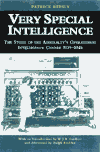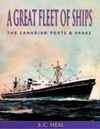Very Special Intelligence
The Story of the Admiralty's Operational Intelligence Centre, 1939-1945
Beesly, Patrick
2000, Greenhill Books, London
ISBN 1853673986
288 pages
| Type. | General History |
| Pros. | Detailed and accurate, rare information |
| Cons. | Nothing major |
| Rating. |  |
 This book, a brand-new reprint of the 1977 original with new introduction and afterword, is written by a member of the British Operational Intelligence Centre (OIC) who took part in unmasking the German codes and their operational planning. This effort was so secret that it was only unveiled in the 1970s, and dozens of books written before that time make of course no mention of this amazing work.
This book, a brand-new reprint of the 1977 original with new introduction and afterword, is written by a member of the British Operational Intelligence Centre (OIC) who took part in unmasking the German codes and their operational planning. This effort was so secret that it was only unveiled in the 1970s, and dozens of books written before that time make of course no mention of this amazing work.
The book starts with a very interesting overview of naval intelligence during WWI when the top-secret British unit known as Room 40 made remarkable inroads into German codes and plans, but the British, for the most part, failed to put its work into operational use, for example at Jutland.
Breaking the German Enigma cypher machine was probably the single most important step in defeating the Germans and especially the U-boats. Beesly covers that and its immense usefulness in actions against the U-boats, Tirpitz and Scharnhorst, and other naval vessels.
Perhaps one of the more interesting stories in the book is how the top-secret and daring German plan to get the Scharnhorst, Gneisenau and Prinz Eugen from Brest, France up the English Channel and to Germany in 1942 was known to the British due to Special Intelligence. Only through a run of bad luck did the British fail to intercept and probably destroy the ships.
His reports on how the British knew pretty much everything about the U-boats at sea is downright chilling and in retrospect the U-boats did amazingly well considering the odds against them. Dönitz and his officers did a few things to really toughen things up for the British but it was eventually all in vain since the German "mail" was almost all being read, revealing it all anyway.
Beesly's account of the main man behind the OIC's effort to counter the U-boats, Rodger Winn, who seemed at times to be reading Dönitz' mind and on whom the centre relied so heavily, is most interesting. A good account is given on the British-American cooperation which began in 1942 and became extremely tight and effective. The British were more calculating while the Americans tended more to risk-taking. This was evident in the operation during the summer of 1943 when the bulk of the German supply boats were sunk within a few weeks - a move the British objected to strongly since they feared this would tip the Germans off and motivate them to change their cypher systems, which would cripple the Allied Special Intelligence work.
The amazing German mistake of not looking harder into the question of Enigma security than they did is of course covered. A few German studies on this matter were conducted and they did in fact reveal the system to be vulnerable under certain conditions but somehow nothing was done about it. The head of German cypher systems always insisted to Dönitz that Enigma was perfect, and while Dönitz did not blindly believe this he probably did not feel he had enough information to reliably debunk that claim.
This book is a real treat for anyone interested in this vital part of the Naval War during WWII and is really well written by a man who is clearly an authority on the matter. Certainly one of the best books on the matter ever written.
Ralph Erskine, who compiled our own Enigma pages, writes a very insightful new afterword to this book. In it he goes over things like how the cypher machine was broken, how the Germans responded and how they might have totally "blinded" the Allies with devices such as Cypher Machine 39, which was absolutely unbreakable during the war but never used.
Highly recommended.
Review written by Guðmundur Helgason.
Published on 24 Feb 2000.
This title is highly recommended.
Purchase information: (info) Get Very Special Intelligence now at amazon.co.uk
Get Very Special Intelligence now at amazon.co.uk
Return to our main review page.



